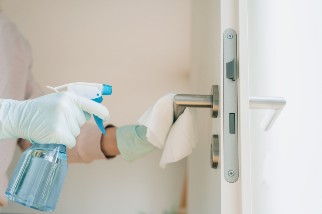 As businesses begin to reopen their doors amid the COVID-19 pandemic, they need to take steps to properly clean and disinfect their facilities to help protect workers, contractors and the public from the virus. CDC has released guidance to help organizations develop protocols for cleaning and disinfecting public spaces, workplaces, businesses, schools and homes.
As businesses begin to reopen their doors amid the COVID-19 pandemic, they need to take steps to properly clean and disinfect their facilities to help protect workers, contractors and the public from the virus. CDC has released guidance to help organizations develop protocols for cleaning and disinfecting public spaces, workplaces, businesses, schools and homes.
The guidance is based around a three-step approach:
1. Develop a Plan
Regardless of the type of facility, your first step should be examining the different surfaces within the work area and what type of cleaning each might need. Many surfaces may only need routine cleaning with soap and water. Other surfaces that are touched more frequently, such as light switches, tables, door knobs, keyboards and desks, should be disinfected with an EPA-approved disinfectant.
If an EPA-approved disinfectant is not available, a gallon of water with a 1/3 cup of bleach added, or 70% alcohol solutions should be used to disinfect. Bleach and other disinfection products
should not be mixed together.
During the planning phase, CDC suggests that you also consider removing or storing soft and porous materials like area rugs and seating to reduce the challenges associated with cleaning and disinfecting them. Furthermore, your plan should be adaptable as guidance is updated and circumstances change.
2. Implement Your Plan
After you’ve examined workplace surfaces and have the cleaning materials you need, put your plan into practice. As a first step, before you use any supplies, be sure to read all manufacturer’s instructions and don gloves and any additional recommended PPE.
The manufacturer’s instructions will provide guidance on any additional PPE needs, whether a surface should be kept wet for a period of time and the proper ventilation needed when using a product. Start the process by cleaning surfaces with soap and water before disinfecting. When applying any cleaning products or disinfectants, refer to the manufacturer’s instructions for dilution, concentration, application, contact time and other considerations.
3. Maintain and Revise Your Plan
Protecting workers’ health in the long-term means maintaining your cleaning and disinfecting protocols as a regular practice, continually assessing your plan to find areas for improvement and instituting additional measures to minimize the risk of exposure. This includes more frequently cleaning and disinfecting high-touch surfaces, and monitoring your supply of disinfectants and PPE.
CDC also advises businesses and organizations to continue practicing social distancing, encourages the use of cloth face coverings, frequent hand washing or use of an alcohol-based hand sanitizer and advising workers to stay home when sick.
Other long-term measures suggested by CDC include leaving certain doors open to avoid touching by multiple people, reducing the use of porous material for seating, removing objects from common areas and opening windows to improve ventilation.
For further information, please see CDC’s Implementation of Mitigation Strategies for Communities with Local COVID-19 Transmission.
Related Links
How Your Safety Management System Can Help in a Pandemic
10 Ways to Reduce Worker Exposure to COVID-19
COVID-19: CDC Guidance on Returning to Work
OSHA and CDC Issue Guidance for COVID-19 Prevention in Meat and Poultry Processing
Three Keys to Addressing COVID-19 in the Workplace